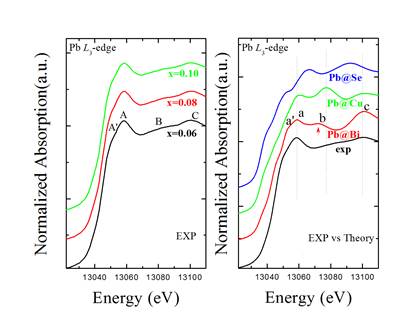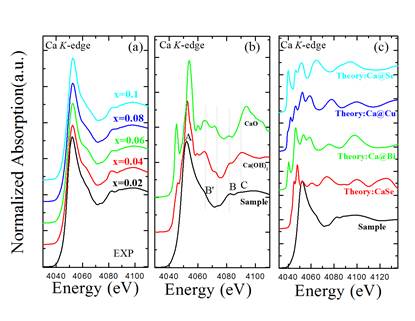| Local structural origin of enhanced thermoelectricity in dually doped BiCuSeO |
| From: PublishDate:2017-06-16 Hits: |
As shown in Figure.1, it is confirmed that Pb ions enter the Bi sites via XANES at Pb L3-edge hard-X-ray. The occupation of Bi sites providing pathways for charge carriers manipulations (J. Mater. Chem. A, 1, 12154-12158. (2013), Adv. Mater. , 25, 5086-5090. (2013)). By contrast, the occupation sites for second dopant-Calcium was not determined directly. The Ca ions, which were not occupying the Bi sites as shown in Figure.2, formed bonds with O ions in the matrix. Interestingly, the Ca-O bond formed a unique hexagonal symmetry CaO2 nanocluster instead of CaO. The nanoclusters are effective scatterers for heat-carriers-phonons generated by lattice collective vibrations. Consequently the thermal conductivity was suppressed. In synergy with electron microscopy, shown in Figure.3, it is revealed that the dual-doping approach can induce a mesoscale structural manipulations which is favorable for thermal stability in comparison with single doped species. It is also demonstrated that dual doped systems can optimize the transport of charge carriers and simultaneously manipulate the phonon heat carriers. This findings pave way for optimization of thermoelectrics. The work was published on Advanced Energy Materials, 6, 1502423-1502431. (2016) |
|
|
| Chinese
- Metal-free efficient photocatalyst for stable visible water splitting——Top ten major scientific progresses in China in 2015
- The nano-resolution imaging platform was awarded the first rate prize of Beijing Science and Technology in 2014
- Beamline 1W1 of BSRF started to runoperate in the couplingparasitic mode of BEPCII
- Synthesis of High Performance Polymer Materials for Field Effect-Transistors
- Surfactant molecular aggregates in green solvents
- GIXRD has played an important role in the characterization of organic thin-film transistors
Science Highlights
Home /
Copyright © 2011 - 2012 Beijing Synchrotron Radiation Facility




